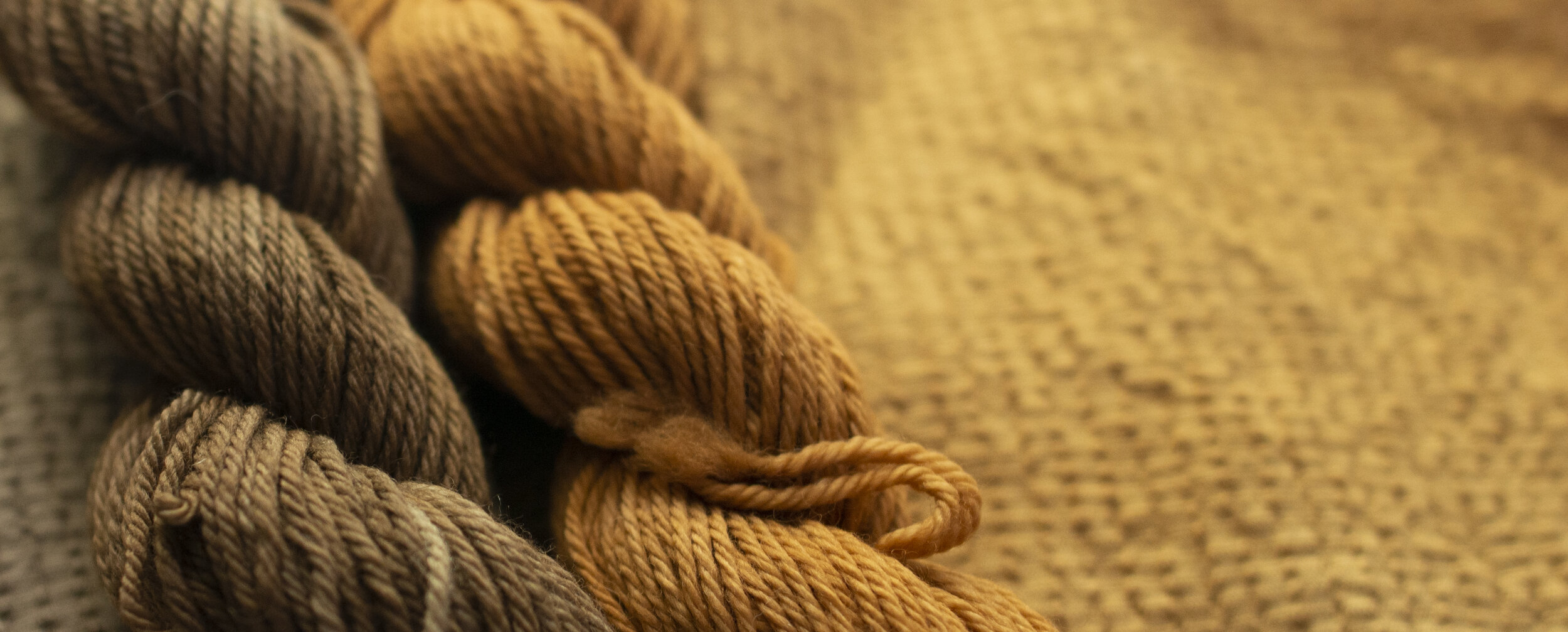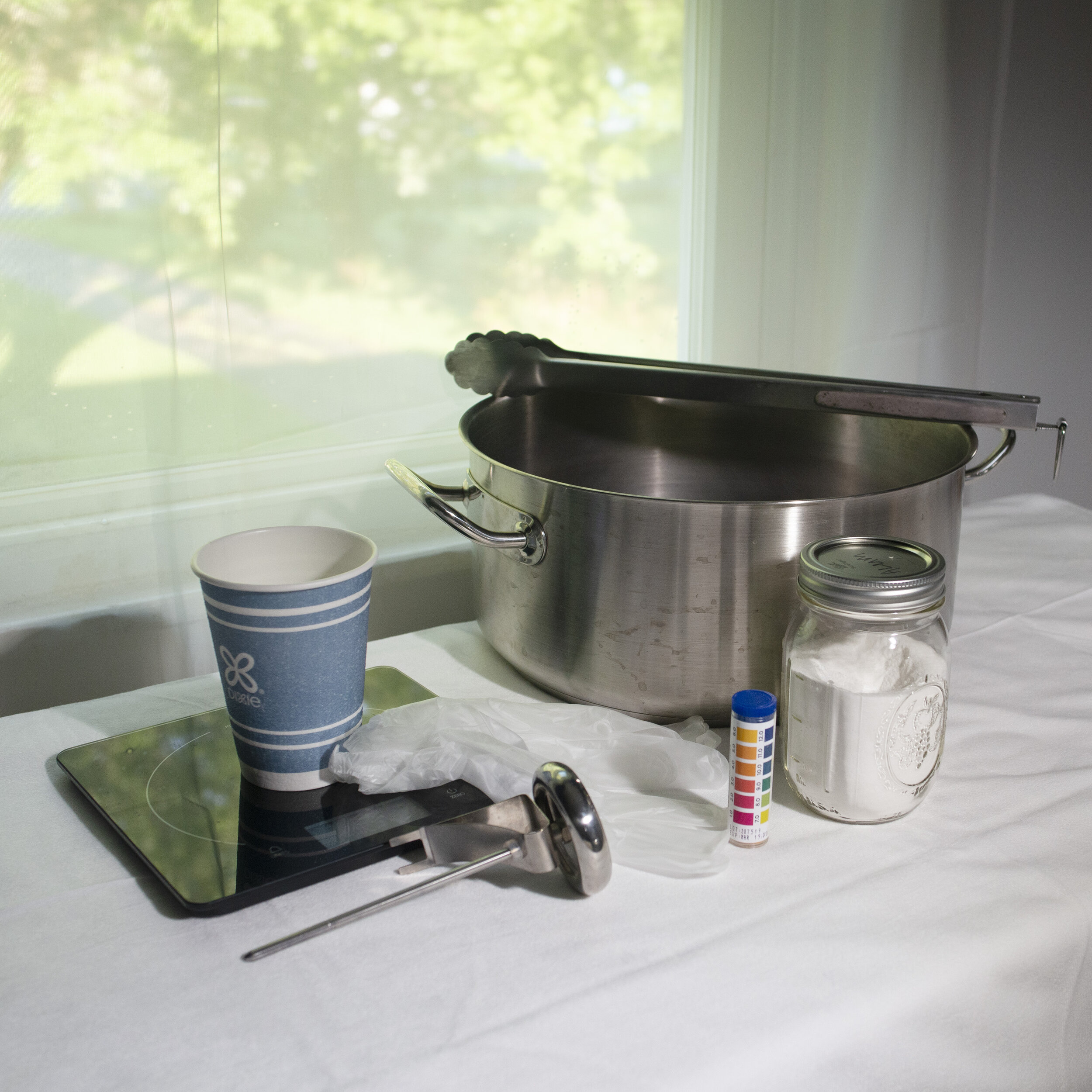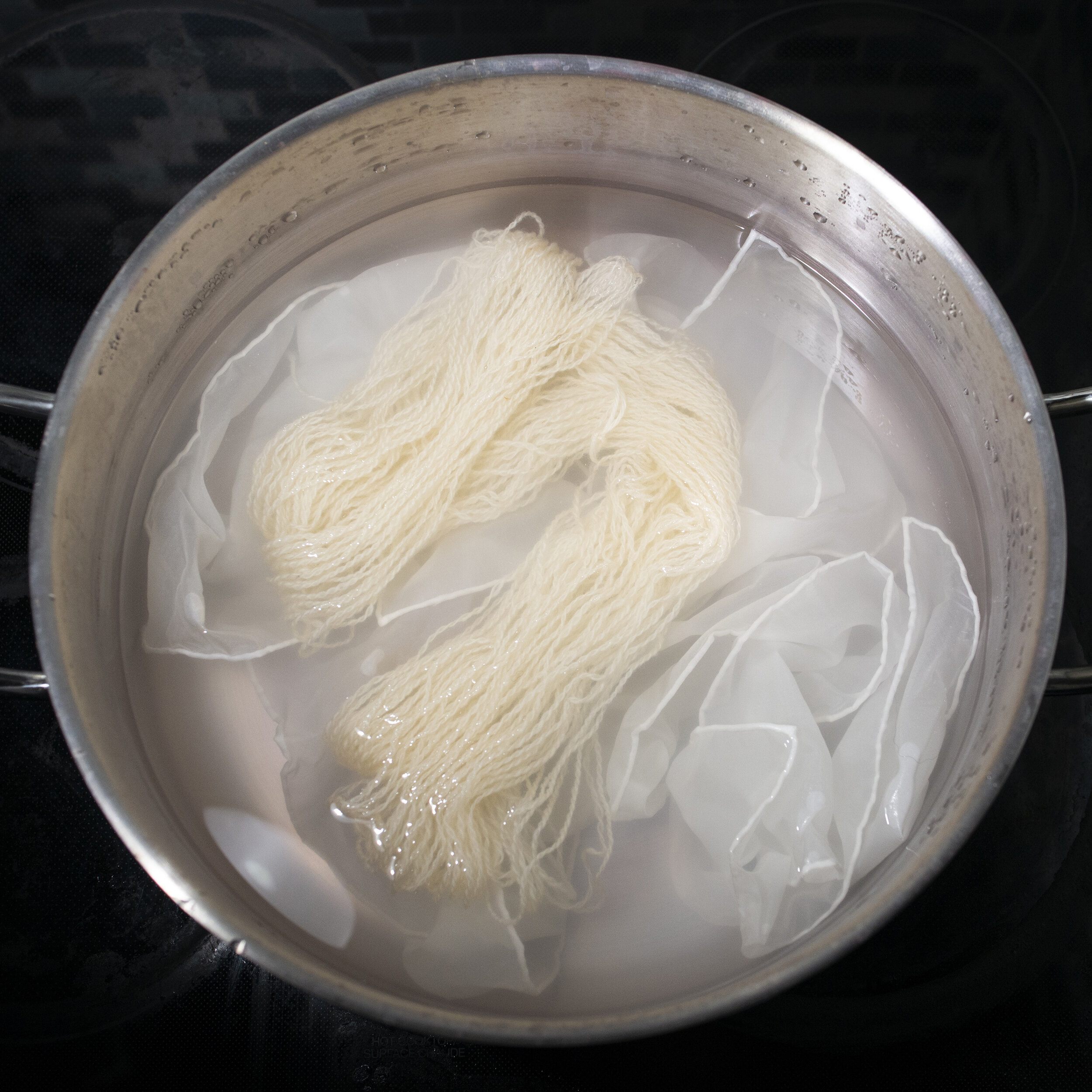
Cutch Extract
A Guide to Cutch Extract
Shepherd Textiles Cutch Extract is made from the Black Cutch tree, acacia catechu. When the wood is boiled in water it yields a tannin-rich syrup: the syrup is dried and ground into a powder to produce cutch. Cutch Extract gives a wonderful, rich cinnamon brown with an alum mordant The color shifts to a deep chocolate brown with the addition of iron. Our Cutch Extract gives medium to strong shades with 5% weight-of-fabric on mordanted fibers, up to twice as strong as other cutch extracts. Product of India. Produced by a GOTS (Global Organic Textile Standard) certified manufacturer.
1. Background on Cutch
Tannin Brew
Cutch comes from the wood of the cutchtree or black cutch, acacia catechu. The tree is native to South and Southeast Asia, from India as far east as the Indonesian archipelago. When the wood is soaked in hot water, a thick, tannin-rich brown syrup leaches out. This syrup is dried and ground to produce cutch. Cutch is highly tannic and highly astringent; it is used for tanning hides, dyeing fabric, and lending a bitter note to certain candies and drinks.
Cutch gives shades of brown on all natural fibers, but the word “brown” does not fully capture the rich, warm shade it can impart. With an alum mordant it gives deep cinnamon browns, and iron will shift the color to chocolate. It is an excellent choice for cellulose fibers, because it is tannic enough to pre-treat them or to use as a dye on its own. For really intense browns on cotton, pre-treat with cutch, mordant with alum, and then dye in a second cutch bath.
2. Safety Precautions
DO NOT INGEST. This extract was prepared for textile dyeing, not as an herbal supplement.
Avoid eye contact. If eye contact occurs, rinse with cool water.
Not for use as a cosmetic additive; do not apply directly to skin or hair.
Open carefully to avoid spilling or creating dust.
If a spill occurs, quickly wipe up with a paper towel or disposable rag.
Cutch Extract can permanently dye clothing, countertops, rugs, utensils, or other property. Avoid contact with anything that is not meant to be dyed.
Use only dye pots and utensils dedicated to dyeing. Do not use any pots, containers, spoons, tongs, thermometers, or other utensils that will be used for food preparation.
Iron powder is an irritant and may be hazardous if ingested. Please read your vendor’s safety sheet (MSDS) before using. Wear gloves, a mask, and eye protection while handling.
Cutch Extract, metal mordants, and all dye baths and mordant liquors made while dyeing should be kept out of reach of children and pets. Use only with adult supervision.
Shepherd Textiles, LLC is not liable for any misuse of this product or any unintended staining of your clothing, workspace, or other property. Use only as directed.
3. Recommended Supplies
Dye pot. Use a dye pot large enough to hold all your fibers, with plenty of room for them to move around and for the liquid to circulate freely. Otherwise, particles of dye may get stuck on the fabric and cause dark splotches.
Metal tongs. A pair of tongs is useful for stirring and taking fabric out. Use tongs dedicated to dyeing, and not for food preparation.
Rubber gloves. Wear rubber gloves while handling extract powder and while handling mordanted/dyed fiber before it is rinsed.
Candy thermometer. The best way to keep track of temperature is to use a candy thermometer that clips to the side of the dye pot.
Scale. Use a scale to weigh out fiber, mordant, and extract powder.
Alum mordant. The alum usually used for mordanting is aluminum potassium sulfate, also known as potash alum. It is the same alum that you can find in a jar in the spice section at the grocery store.
Disposable cup. For mixing the extract powder to a paste.
4. Preparation: Mordanting with Alum
Cutch Extract can be used without a mordant, even on cotton, although the browns it produces will be more pale. It bonds most effectively to fibers that have been mordanted with alum. For best results, soak your fibers in water for a few hours before mordanting, so that the mordant will penetrate deeply and evenly. Make sure to weigh the fibers first, while they are still dry.
Alum will dissolve quickly into hot tap water.
Heat fibers for an hour at 180F, then allow to cool.
For all fibers (wool, silk, cotton, etc.): Mordant at 12% WOF with alum.
Weigh out the fibers you plan to dye (while they are dry). Multiply that weight by 0.12 to get the amount of alum you will need.
Fill your dye pot with hot tap water, leaving enough room for the fiber.
Weigh out the correct amount of alum and pour it into the dye pot. Mix with a spoon or metal tongs until it has dissolved.
Gently place your fibers into the mordanting solution.
Heat mordant bath to 180F and maintain heat for 1 hour. If you don’t have a candy thermometer, you will have to estimate the temperature. At 180F, steam vapor will be rising off the water but it will not be bubbling. If your mordant bath starts to bubble, turn down the heat.
Stir every 15 or 20 minutes to make sure fibers mordant evenly. If they do not, the dye will take better in some places than others.
After an hour, remove from heat and let cool to room temperature. Once cool, you can immediately proceed to rinsing, or you can leave the fibers to steep overnight in the mordant bath. This will improve results, especially when dyeing thick or tightly woven fabrics.
Remove cooled fibers. Wearing rubber gloves, gently squeeze excess mordant solution back into the pot. Rinse briefly in lukewarm water. The fiber does not need to be thoroughly washed, but any excess alum should be rinsed out. Set aside until ready to dye. Keep out of reach of children and pets.
Dispose of mordant solution according to local guidelines.
Note for cellulose fibers (cotton, linen, etc.): Scour well before mordanting as described above.
Cutch Extract is tannic enough that it can be applied to cellulose fibers without using a mordant. However, for the brightest, strongest cinnamon and chocolate browns, be sure to scour the fibers well and treat them with a tannin and mordant first.
Scour cellulose fibers well. Traditionally this is done in a highly alkaline soda ash solution. Add 2 tsp of soda ash and 1 drop of dish soap to a 5-gallon dye pot. Add cellulose fibers and heat to 180F-190F for an hour, stirring occasionally. Remove from heat, and when cool enough to handle, rinse and wring out well. Household detergents like Tide© are also alkaline (PH 11), so you can also just toss the fiber in a washing machine on a high-temperature cycle with plenty of detergent. This will not clean them as deeply, but may be sufficient for basic dyeing projects.
[OPTIONAL] Apply a tannin to the scoured fabric. Cutch Extract or Gum Arabic Extract are the best choices. To use, fill your dye pot with hot water, dissolve 3-5% WOF of the extract into the dye bath, and simmer for an hour. This process will make the cotton or linen more receptive to alum and lay down a base of color. Be sure to keep the fiber moving around: some tannins have insoluble particles that love to get stuck in fabric, and they can cause splotches later on in the dyeing process. After an hour, let cool, remove fibers, and rinse well.
Mordant with alum as described above for protein fibers.

The Recipes
5. Recipe: Cinnamon Brown
The basic recipe for Cutch Extract is to use 5% weight-of-fabric (WOF) on alum-mordanted fiber to produce a cinnamon brown. The depth of color will depend on the fiber type and how thoroughly it is mordanted. Increase to 10% WOF for very dark browns.
Fill your dye pot with warm water, making sure there is enough room for the fabric to move around and for water to circulate freely.
Weigh out 5% weight-of-fabric (WOF) Cutch Extract into a disposable cup (multiply the dry weight of the fabric by 0.05 to get the correct amount of extract).
Add a little hot water to the cup and mix to form a thin slurry. Make sure to break up any clumps of powder, otherwise they may cause splotches on your fiber.
Pour the Cutch Extract slurry into the dyebath and mix well. At this point the dyebath will be a dark red-brown color.
Add your pre-mordanted, wetted fibers to the dyebath.
Raise the temperature to 170°F for protein fibers or 190°F for cotton. Maintain for 1 hour to 1.5 hours, stirring every 20 minutes or so to make sure everything dyes evenly.
After 1 or 1.5 hours, remove pot from heat and allow to cool to room temperature.
Remove the fibers and rinse briefly in lukewarm water to remove any particles of dye. You can either proceed immediately to rinsing with detergent, or hang the fabric up to dry first to help the color set. Make sure to hang it up somewhere where dripping dye will cause no damage.
For final rinsing, we recommend using a PH-neutral detergent like Synthrapol, it is designed to wash out loose dye. Follow the manufacturer’s directions for best results. CAUTION: Cutch Extract may bleed if not thoroughly rinsed out after dyeing.
Hang up to dry.
6. Recipe: Chocolate Brown
Iron shifts the color of Cutch Extract to chocolate brown. We recommend using iron as an afterwash, especially on wool, which can be damaged by extended contact with iron solution. However, silk and cotton could be mordanted with 2% iron, instead of alum, to get a similar effect.
Follow the recipe for “Cinnamon Brown.” After Step 6, when the fiber is well dyed, there are two ways to shift the color to “Chocolate Brown.”
Add 2% WOF iron powder directly to the dyebath, and simmer at 180F for another 5-10 minutes until the color has shifted. If possible, pull the fiber out when you add the iron powder so that it doesn’t touch anything before it dissolves; if it does, it can cause splotches.
Make a separate iron wash bath in a different dye pot. Fill it mostly full with hot water and add 2% WOF iron. Mix until dissolved. Heat the iron wash bath to 180F, add the dyed fibers, and simmer for 5-10 minutes until the color has shifted. You can also use this separate bath on fibers that have already been rinsed and dried—just be sure they are thoroughly wetted before going into the iron wash.
After the color has shifted, remove the fibers as soon as they are cool enough to handle. The goal is to rinse off any unbonded iron before it can start corroding the fiber and making it feel coarse. We often pull the fiber out with tongs and gently plunge it into a bucket of water the same temperature as the dyebath; this prevents any temperature shocks that can cause wool to felt. Rinse well in hot water to remove any particles of iron. You can either proceed immediately to a full rinse with detergent, or hang the fabric up to dry first to help the color set. Make sure to hang it up somewhere where dripping dye will cause no damage.
For final rinsing, we recommend using a PH-neutral detergent like Synthrapol, it is designed to wash out loose dye. Follow the manufacturer’s directions for best results. CAUTION: Gum Arabic Extract may bleed if not thoroughly rinsed out after dyeing.
Hang up to dry.
All images and text are copyright of Shepherd Textiles, LLC. Do not reproduce without permission and attribution.






